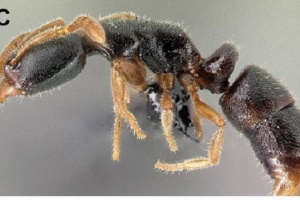New endemic ant species discovered on Seychelles' Silhouette Island
Species |Author: Juliette Dine Edited By: Betymie Bonnelame | August 3, 2023, Thursday @ 14:16| 25339 views
The new species does not yet have a Seychellois Creole, English, or French name. (Brian Fisher)
A new ant species named Ponera adumbrans, which means obscuring or silhouetting in Latin, has been discovered on two islands of Seychelles; Silhouette and Mahe.
According to the authors of a study in the journal "Organisms Diversity & Evolution," the name refers to the obscure origin of this species in the Malagasy region and the type of locality on Silhouette Island.
According to Pat Matyot, a trustee of the Silhouette Foundation, "This type of ant is very rare that most people will never see it. Its DNA is different from that of the other 80 species of ants recorded in Seychelles."
The new species does not yet have a Seychellois Creole, English, or French name and American myrmecologist Brian Fisher, who first collected the specimen, is inviteing the people of Seychelles to nominate a name for the ant.
Specimens on which the description is based were collected by Fisher in January 2010 in leaf litter and rotten wood on the ridge leading to Mont Corgat on Silhouette Island. Another specimen was found on Mont Copolia on Mahe, the main island.
Fisher and his colleagues, including students, have been looking at the ants they collected all over the western Indian Ocean, and studying each group of related species in turn.
Although the specimens were collected from Seychelles in 2010, it is only now that they have been able to publish the description of this one.
Fisher was assisted by the staff of most of the environmental organisations in Seychelles. These included the Department of the Environment, the Seychelles Islands Foundation and the Island Conservation Society (ICS). ICS runs conservation programmes for the state-owned Islands Development Company on Silhouette and other islands of the archipelago.
Research has proven that this species is new to science and has never been found anywhere else in the world.
"Brian and his team are establishing a clear inventory of what ants are found in Seychelles. They are describing and naming species we did not know about before. In the end, we will have this inventory that will enable us to have a more precise picture of our ant fauna - the native species that need to be protected as well as the invasive alien (introduced) ones that we need to keep under control," said Matyot.
He added that "ecologists and conservationists will benefit from the work done by Brian and his team. Other scientists will be able to focus on particular species and work out the details of their biology."
The experts say that this species of ant does not present a threat to other species and "the fact that it is rare and found in only a couple of higher altitude places suggests that this ant itself could be vulnerable to invasive ants such as the big-headed ant (pti fourmi rouz gro latet in Creole) and the yellow crazy ant (fourmi Maldiv in Creole) and the destruction of native vegetation may be a serious threat to them as well," said Matyot.
Fisher, who is interested in the origin and radiation of ants in the Southwest Indian Ocean (SWIO) across the different island groups, said that Seychelles is unique in that many ant genera show a relationship with Asian ant fauna. In contrast, other island systems show a stronger relationship with Africa.
"We still have over 10 new species to describe from the island. One species, Stigmatomma besucheti, from La Digue, has not been collected since its original collection. I must return to find this new species," said Fisher.
The Island Conservation Society (ICS) says that a new species further highlights that Silhouette is a biodiversity hotspot.
"It also shows that hidden gems like this new species can still be discovered on an island like Silhouette -as its challenging topography makes for equally challenging conservation explorations, and therefore there is still plenty to potentially be discovered on Silhouette," said Nasreen Khan, a conservation officer of ICS on Silhouette.
The ICS team will be embarking on an expedition with the Seychelles National Herbarium and with the Plant Conservation Action (PCA) group to undertake exploration on rare plant species. Among these will be collecting invertebrate samples.
"If we do find this species on another side of the island, it would be adding more detail to the limited knowledge we have, moreover it would also be exciting to have collected a sample of the new species, 13 years after Brian Fisher," said Khan.
Back
